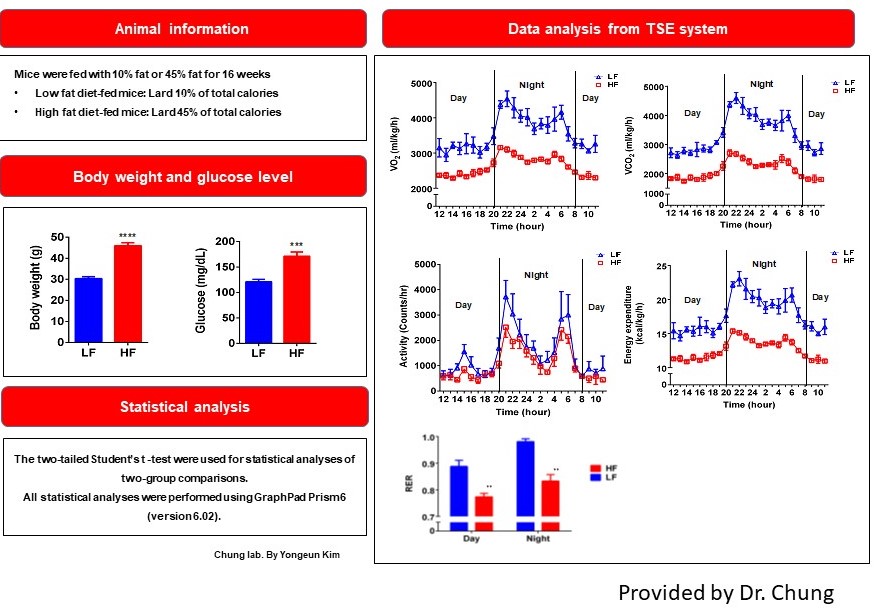TSE Phenomaster/Labmaster caging system (located in the Life Sciences Annex) is a multi-modular platform that allows researchers to carry out metabolic, behavioral, and physiological studies by monitoring mice in an automated and synchronized manner. Currently, our system consists of 12 cages with modules to measure mouse metabolic performance, activity, plus feeding and drinking behavior. Mice are acclimated in acclimation cages that are similar to the experimental cages, with one mouse per cage. Acclimation starts the Wednesday before the experiment, with the experiment running Monday-Friday.
The components measured by the system are:
- Calorimetry:
- Airflow (l/min)
- Temperature (0C, measurement in the box)
- O2 concentration (%, reference and per box)
- CO2 concentration (%, reference and per box)
- dO2 difference (%, reference O2 – Box O2)
- dCO2 difference (%, reference CO2 – Box CO2)
- VO2 (O2 consumption, ml/(kg x h) or ml/h)
- VCO2 (CO2 production, ml/(kg x h) or ml/h)
- RER, respiratory exchange rate (VCO2/VO2)
- H, heat (kcal/(kg x h) resp., or Kcal/h)
- The TSE system is carefully calibrated using certified calibration gases whose O2 and CO2 concentrations are accurately known.
- Activity measurements via MoTil2 IR sensor frames and/or a passive wheel. The IR sensor frames are configured to measure locomotor activity in the x, y, and z planes. The software records the number of beam interruptions caused by the animal’s movement. The total number of beam breaks recorded is a sum of the ambulatory and fine movements. A passive wheel (of which there are 4) allows measurement of spontaneous activity by the animal with the number of turns the wheel makes clockwise or counterclockwise being recorded.
- Drinking and feeding behavior for each animal in each cage is recorded via the sensors the drinking and feeding stations are attached to. Defined calibration weights are also used to calibrate the drinking and feeding system which allows accurate monitoring of how much food an animal eats and how much water it drinks.
Application
- Pharmacology of diabetes/obesity
- Space physiology-metabolism
- Microbiota & energy metabolism
- Phenotyping-Huntington disease activity
- Phenotyping-Running-Open field
Workflow
Day 0: Mice are brought/sent to room 23A and placed in acclimation chambers with clean bedding, food, and water.
Day 0-5: Monitor mice to make sure they are acclimating to the chambers and surroundings.
Days 5: Move mice to experimental chambers with clean bedding, food, and water.
Day 5-9: Monitor mice in experimental chambers.
Day 9: All mice are retrieved directly by the investigator to terminate or place back in housing.
All equipment was cleaned and disinfected per individual posted instructions.
Typical data
